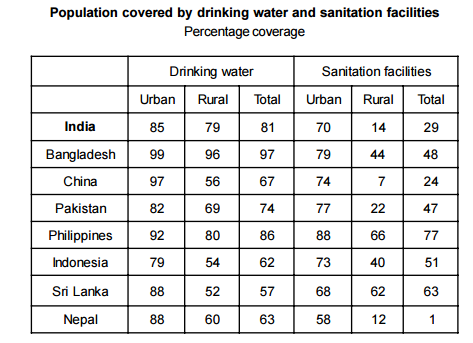Hello and welcome to exampundit . So, here is a set of Data Interpretation and Analysis Quiz for IBPS PO Mains 2016.
on the following information. The table below presents data on percentage
population covered by drinking water and sanitation facilities in selected
Asian countries.
percentage in total coverage for both drinking water and sanitation facilities,
and, B is said to be dominated by A, or B < A. A country is said to be on
the coverage frontier if no other country dominates it. Similarly, a country is
not on the coverage frontier if it is dominated by at least one other country.
are the countries on the coverage frontier?
following statements are true?
data presented under ‘sanitation facilities’ columns, it can be concluded that
rural population in India, as a percentage of its total population is
approximately
the data presented under ‘sanitation facilities’ columns, sequence China,
Indonesia and Philippines in ascending order of rural population as a percentage
of their respective total population. The correct order is
the coverage frontier because
drinking water facilities.
sanitation facilities.
sanitation facilities.
following information. These relate to the above table with the additional provision
that the gap between the population coverages of ‘sanitation facilities’ and
‘drinking water facilities’ is a measure of disparity in coverage.
the most disparity in coverage of rural sector is
(adsbygoogle = window.adsbygoogle || []).push({});
the least disparity in coverage of urban sector is
Read the following information and answer carefully.
part of his money in the stock of four companies — A, B, C and D. Each of
these companies belonged to different industries, viz., Cement, Information
Technology (IT), Auto, and Steel, in no particular order. At the time of
investment, the price of each stock was Rs.100. Sudhir purchased only one stock
of each of these companies. He was expecting returns of 20%, 10%, 30%, and 40%
from the stock of companies A, B, C and D, respectively. Returns are defined as
the change in the value of the stock after one year, expressed as a percentage
of the initial value. During the year, two of these companies announced
extraordinarily good results. One of these two companies belonged to the Cement
or the IT industry, while the other one belonged to either the Steel or the
Auto industry. As a result, the returns on the stocks of these two companies
were higher than the initially expected returns. For the company belonging to
the Cement or the IT industry with extraordinarily good results, the returns
were twice that of the initially expected returns. For the company belonging to
the Steel or the Auto industry, the returns on announcement of extraordinarily
good results were only one and a half times that of the initially expected
returns. For the remaining two companies, which did not announce
extraordinarily good results, the returns realized during the year were the
same as initially expected.
minimum average return Sudhir would have earned during the year?
35% return on average during the year, then which of these statements would
necessarily be true?
2. II and III only
4. II and IV only
during the year, then which of these statement(s) would necessarily be true?
belonged to the Cement or the IT industry and did announce extraordinarily good
results, then which of these
statement(s) would necessarily be true?
announced extraordinarily good results.
belonged either to Auto or to Steel Industry.
Solutions:
- B
- C
- B
- C
- A
- D
- A
8). 1
==> 120 (Twice of 10% on 100) + 130 (1 1/2 times of 20% on 100 ) + 130 (No Change) + 140 (No Change) = 520 .:. 30%
9). 2
==> To earn 35 % on average Total should be = 540
Which can be calculated as :
110 (B, No Change) + 130 (1 1/2 times of 20% on 100 Thus A is Auto or Steel ) + 160 (Twice of 30% on 100 thus C is Cement/IT co.) + 140 (D, No Change) = 540
Thus, 2.
10). 3
==> 38.75% avg profit .:. Total sale = 555
120 + 110 + 145 (1 1/2 times of 30% on 100 on C Thus Auto/Steel) + 180 (Twice of 40% on 100 on D
Thus Cement/IT) = 555
11). 2
160 (Twice of 30% on 100 on C
Thus Cement/IT) + 115 (1 1/2 times of 10% on 100 on A
Thus Auto/Steel) + 120 + 140 = 535 .:. 33.75% average returns.
Regards
Team ExamPundit




